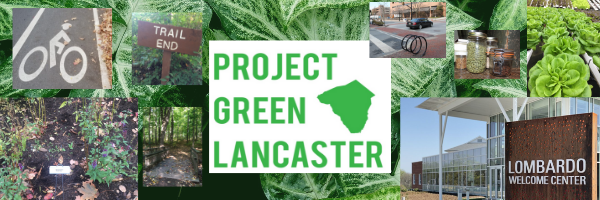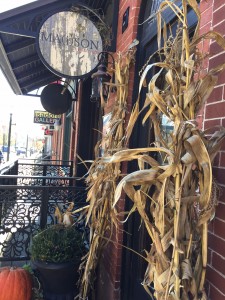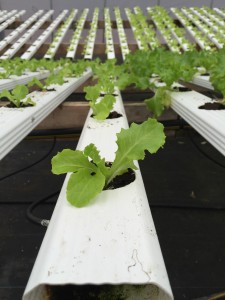Urban Cookery
Photo by: A. Black
Local farm-to-table restaurant, Ma(i)son takes on sustainable efforts through the use of hydroponics. A simple yet intimate atmosphere provides a unique French-Italian style toward a more sustainable dinner choice.
What is Ma(i)son?
Ma(i)son is a locally run restaurant that offers a simple farm-to-table cuisine style to all local neighbors and friends. Founded in 2011 and located in downtown Lancaster, the family owned business takes pride in nourishment and sustainability when it comes to the process of food they provide.
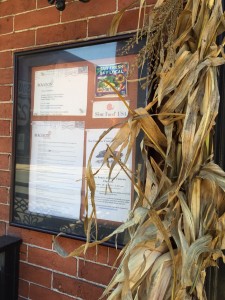
How did the Name Originate?
A cookery is “the practice, art and skill of preparing food as well as a place in which food is cooked.” Ma(i)son is known as an urban cookery in regard to the definition of cookery as well as the urban location.
The name originates from the French word meaning house or home, which is maison along with the family name of Mason. The family translated the name of the restaurant as “Mason’s house” resulting in Ma(i)son.
Tradition
The family lives right above the restaurant and ultimately believes Ma(i)son is an extension of their hom e. They incorporate both tradition and heritage into everything they do and serve. The family practices early techniques by creating simple yet sustainable cuisine, provided to all neighbors and friends within the community.
e. They incorporate both tradition and heritage into everything they do and serve. The family practices early techniques by creating simple yet sustainable cuisine, provided to all neighbors and friends within the community.
Cuisine Focus
Ma(i)son uses past traditions and techniques as their approach toward all of the cuisine they prepare.They strive to provide only the best ingredients found locally in Lancaster County as well as the Susquehanna River Valley. Ma(i)son’s mission is to provide simple yet sustainable ingredients, which provide the most abundant nourishments and benefits. Their pride is 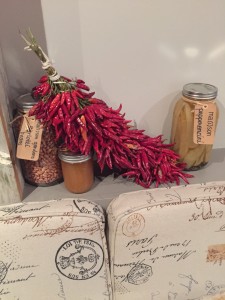 maintained through the close relationships with both farmers and artisans who help supply Ma(i)son with sustainable and fresh food.
maintained through the close relationships with both farmers and artisans who help supply Ma(i)son with sustainable and fresh food.
Slow Food USA
As proud members of Slow Food USA, Ma(i)son is honored to be part of the organization. Slow Food USA is part of the Global Food Network with over 100,000 members reaching more than 150 countries. They are motivated through cleaner, more sustainable means of food preparation. Their niche is “the future of food is the future of the planet.” Organizational tasks include coordinating local activities, projects and events to preserve as well as share local foods and expand on different cultures. The mission behind Slow Food USA involves educating others about preserving food culture, adding participants as well as volunteers, and to increase potential awareness about the importance of knowing where our food comes from.
Photos by: A. Black
Connections
The many connections who supply Ma(i)son with fresh and sustainable food are considered friends.
- Brogue Hydroponics
- The process of growing plants without soil; grown in sand, gravel, or liquid with added essential nutrients.
- Supplies flavorful herbs, greens, lettuce, and edible flowers year-round.
- Lime Valley Mill Farm
- Provides produce from a variety of vegetables as well as lamb and beef when available.
- Tulip Tree Hill Farm
- Supplier of produce, chicken, duck, and wheatgrass.
- Mili’s Bakery
- Supplies bread and other dessert items.
- Buck Hill Farm
- Grows specific seeds in regard to Ma(i)son’s interests.
- Wenger Farm
- Provides a variety of custom vegetables, herbs, fruits, and edible flowers.
- Susquehanna Permaculture

Photo by: A. Black
- Sustainable farm as well as providing depth and educational awareness about healthy agriculture.
- Farm Fromage
- Supplies an array of artisan, hand crafted cheeses.
- Sweet Stem Farm
- Supplier of meat, while ensuring their animals are without the use of antibiotics and free of any synthetic hormones.
- Groff’s Farm
- Provider of great quality seasonal vegetables.
Every connection drives Ma(i)son to success by supplying sustainable agriculture to their business. Friends and businesses work together and continue to hold similar beliefs as to providing the highest quality of food to local areas. Ma(i)son holds their relationships and connections to the highest standard by continuing to provide exceptional products to meet their farm to fresh atmosphere.
What is Hydroponics?
The word hydroponics derives from Latin, meaning working water. It is a subset of hydroculture, which allows plants to grow using mineral nutrient solutions. This allows plants to be grown by their roots and without the use of soil. A subset of soilless culture, hydroponics makes growing plants year-round possible. Using controlled environment systems, Brogue Hydroponics is one Ma(i)son’s leading supplier of sustainable vegetables year-round.
How it Works
Hydroponics gives plants exactly what they need when they need it. It is easy to maintain plants, making them as healthy as possible. The process has a faster and more efficient growth rate compared to the traditional ways of using soil. This makes hydroponics a highly productive system in regard to conserving water and land as well as protecting the environment.
Two essential techniques of hydroponics are solution culture and medium culture. Solution culture primarily uses just the nutrient solution rather than using a solid medium for the roots. On the other hand, medium culture does consist of a solid medium in the form or sand, gravel, or rockwool culture.
Hydroponics in Brogue
Bob and Nancy Kilgore founded Brogue Hydroponics in 1983. They currently have six greenhouses with an additional one in the making. All of the greenhouses have a variety of lettuces, herbs, tomatoes, red raspberries, garnishes, and edible flowers. They take pride in supplying only the best ingredients locally.
Specifically, Brogue uses nutrient solutions; water containing fertilizers with the use of perlite and peat moss to add support. Brogue Hydroponics is made up of a closed system in which excess solution is recovered, replenished, and recycled. They also use Integrative Pest Management in all of their greenhouses, which helps pest control and prevents possible damages that may be harmful to people, the environment, and structures.
Unique Techniques
- Wick System
- Simplest type involving a passive system, which involves no moving parts.
- Nutrient solution is drawn into the medium with a wick. Styrofoam holds the plants
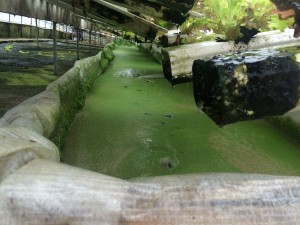
Photo by: J. Abate
and floats directly on the nutrient solution.
- Water Culture
- Simplest form of all active systems.
- Great system for growing lettuce, ideal for fast growing water loving plants.
- EBB & Flow (Flood and Drain)
- Works by temporary flooding the tray that carries the nutrient solution and then draining the solution back into the reservoir. Done by a submerging pump, which is connected to a timer.
- Drip Systems (Recovery and Non-recovery)
- Most popular and widely used.
- Operated by a timer, allowing the pump to be turned on and nutrient solutions are then dripped into the base of each plant by a drip line.
- Nutrient Film Technique
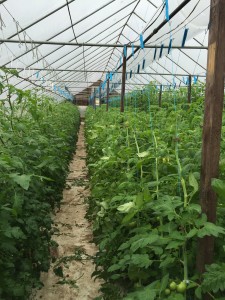
Photo by: J. Abate
- Offers a consistent flow of nutrient solutions without the use of a timer. No growing medium other than the use of air.
- Aeroponics
- Most advanced system. Similar to the Nutrient Film Technique, this system’s growing medium is primarily air. Plant roots hang in the air and are misted with nutrient solutions every few minutes for just a few seconds.
- The growing medium, water, nutrients, and light all play a vital role in the production of all hydroponics systems.
Advancements
A major advantage with using hydroponics is reducing pest problems. Within the controlled environment, pests are less likely to ruin produce due to the extent of nutrients being fed to just the roots. The use of hydroponics allows natural elements to aid in the growth of sustainable agriculture as well as providing an eco-friendly environment. Farm to table style urban cookery, Ma(i)son absorbs the use of hydroponics to reach sustainable efforts.
Glossary
Urban cookery – The practice, art and skill of preparing food and a place in which food is cooked.
Farm-to-table – Refers to the various processes in the food chain from agricultural production to consumption.
Slow Food USA – Global Food Network with over 100,000 members reaching more than 150 countries, motivated by cleaner, more sustainable means of food preparation.
Hydroponics – Process of growing plants using mineral nutrient solutions, grown by their roots and without the use of soil.
Integrated pest management – A broad-based approach that integrates practices for economic control of pests.
References
Cookery. (1996-2015). Retrieved from http://www.yourdictionary.com/cookery
Farm-to-table. (2015). Retrieved from https://en.wikipedia.org/wiki/Farm-to-table
Hydroponics. (2015). Retrieved from https://en.wikipedia.org/wiki/Hydroponics
Kilgore, B. (2015, November 11). Personal Interview.
Kilgore, N. (2015). Brogue Hydroponics. Retrieved from http://www.broguehydroponics.com/
Ma(i)son. (2009-2015). Retrieved from http://www.maisonlancaster.com/
Simply hydroponics and Organics. (2008). Retrieved from http://www.simplyhydro.com/system.htm
Slow Food USA. (2015). Retrieved from https://www.slowfoodusa.org/
University of California Agriculture & Natural Resources. (2014). Retrieved from http://www.ipm.ucdavis.edu/GENERAL/ipmdefinition.html
